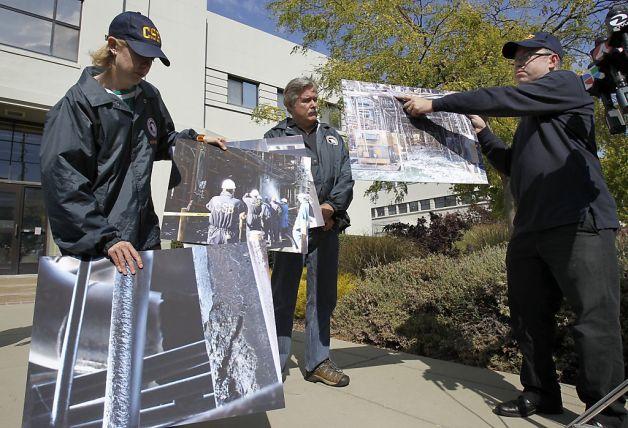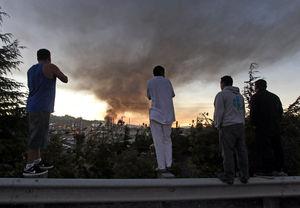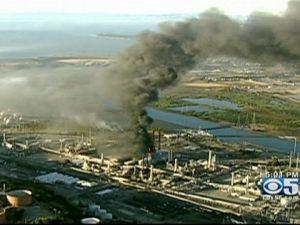Last night, Barbara Smith of Chevron updated Richmond City Council members with the following:
- We continue to listen to input from the community and to respond as promptly and forthrightly as possible. We are coordinating with neighborhood councils and the RNCC to participate in upcoming meetings, which provide a forum for listening and sharing information.
- 7448 claims have been processed through the hotline and 1270 have been processed through the claims center.
- CSB held a press conference at 4pm this afternoon at which they gave an update on their investigation. They are providing video and photos at a dropbox: https://www.box.com/s/d29a3f280785a7f904dd
Some recent media coverage is copied below:
Click here for photos of damage by the Chemical safety Board.
Chevron fire ignited by idling rig?
Jaxon Van Derbeken and Demian Bulwa
Updated 11:46 p.m., Tuesday, August 14, 2012

Members of the Chemical Safety Board juggle photographs of the scene of the scene outside Chevron. Investigators from the federal Chemical Safety and Hazard Investigation Board discussed their early findings into the fire at the Chevron refinery in Richmond, Calif. Tuesday August 14, 2012.
Photo: Brant Ward, The Chronicle / SF
The Richmond refinery fire that sent more than 9,000 people to emergency rooms could have been touched off when a cloud of flammable vapor reached an idling and abandoned Chevron fire truck, investigators said Tuesday.
A company surveillance videotape that captured the two minutes before the blast showed that a dense vapor cloud fueled by the leak expanded to more than 200 feet wide and 200 feet high at the refinery's Crude Unit No. 4, surrounding as many as a dozen workers, who fled just in time.
"They were enveloped by a vapor cloud that later ignited when it found an ignition source," said Don Holmstrom, an investigator for the U.S. Chemical Safety Board, which is overseeing the fire investigation. The inquiry has involved 50 interviews and scrutiny of thousands of pages of documents.
Holmstrom noted that a likely source of ignition was the idling rig's diesel engine, but stressed that exactly what set off the cloud may never be known for certain.
Diesel engines have been tied to earlier refinery accidents, including the devastating 2005 explosion that killed 15 workers and injured scores of others at the BP refinery at Texas City, Texas. That accident occurred when an idling diesel pickup truck drew in flammable hydrocarbon vapors and exploded, hitting trailers full of workers.
Narrow escape
The source of the vapor plume at the Richmond refinery is believed to be an 8-inch pipe carrying super-heated hydrocarbons from the crude unit to be cooled and processed into fuel elsewhere in the facility. Repair crews were at the scene to assess what was assumed to be a minor leak in the pipe and narrowly escaped death in the Aug. 6 explosion and fire, investigators said.
Key lines of the investigation are the decision to leave the crude unit in service after the leak was discovered and the determination last fall that the 40-year-old, 8-inch pipe could be safely left in service even while a companion line was replaced because of corrosion, said Daniel Horowitz, managing director of the Chemical Safety Board.
The Chronicle reported Tuesday that Chevron considered but rejected replacing the 8-inch line last year and judged it safe for five more years. The company has said it is premature to comment on that decision, but investigators said the decision was a fateful one.
"This line was not replaced," Horowitz said. "We are very much interested in understanding the decision about why to keep this line in service - I'm sure that everybody wishes that decision might have turned out differently."
The inquiry has been hampered by limited access to the site. Investigators wearing respirators are not able to come closer than 10 feet from the ruptured pipe because of structural safety concerns. They have taken several photographs of the rupture site that show the cracked line that peeled open before the fire.
9,000 seek treatment
Earlier in the day, Contra Costa County health officials announced that more than 9,000 people have sought emergency room medical attention for breathing problems and other health issues that might be related to the fire.
While earlier reports indicated no one had been admitted to a hospital, officials said it now appears that two or three people were hospitalized, including a girl who was admitted to Children's Hospital Oakland after reporting her asthma was made worse by smoke.
Dr. Wendel Brunner, director of public health for Contra Costa County, said many people were sickened by particulate matter in the smoke - those levels are still being studied by regional air quality regulators.
Brunner's report to the county Board of Supervisors came as a local environmental advocacy group said that it had been invited to join an investigation of the fire.
The group, Communities for a Better Environment, said it will take part in an analysis required by overlapping industrial safety ordinances in Contra Costa County and the city of Richmond.
Read more: http://www.sfgate.com/bayarea/article/Chevron-fire-ignited-by-idling-rig-3788080.php#ixzz23ctB6anm
Antonia Juhasz
Los Angeles Times
Tue, 14 Aug 2012 20:56 CDT


© Lance Iversen / San Francisco Chronicle / Associated Press
People view the fire at the Chevron Richmond Refinery. The fire burned out of control for more than five hours, sending a giant black cloud of toxic chemicals, including sulfur dioxide and nitrogen oxide, thousands of feet into the air and out across the bay.
The facility that caught fire violates pollution rules and is a daily threat to workers and neighbors.
Stay inside, close your windows and doors, and turn off air conditioning and heating units. Pets and all children in sporting activities should be brought inside, and have duct tape ready should you need to further seal windows and doors.
These are among the "shelter in place" warnings made to Bay Area residents last week in response to a massive fire at theChevron Corp.refinery in Richmond. The fire burned out of control for more than five hours, sending a giant black cloud of toxic chemicals, including sulfur dioxide and nitrogen oxide, thousands of feet into the air and out across the bay. While automated calls went to more than 18,000 people, some 160,000 residents live in the areas directly affected by the warning. More than 5,700 people have sought medical treatment.
Chevron is the world's eighth-largest corporation and hands-down the largest in California. The Richmond refinery is also the state's single largest contributor to greenhouse gas emissions, having released 4.5 million metric tons of greenhouse gases in 2010 alone.
Built in 1902, the refinery shows its age. Rather than use its $27 billion in 2011 profits to run the cleanest, safest and most transparent refinery possible, Chevron operates a refinery that is in constant violation of federal and state law and a daily threat to the health and safety of its workers and neighbors.
More than 25,000 people, including those in two public housing projects, live within just three miles of the refinery. Nearly 85% of the residents live below the federal poverty line; the same percentage is listed as "minorities" according to the U.S. Census. Within one mile of or abutting the refinery are businesses, houses, an elementary school and playgrounds.
Since at least April 2009, the refinery has been in noncompliance of the Clean Water Act and the National Pollutant Discharge Elimination System in every quarter but one. Until July 2010, the refinery had been in "high-priority violation" of Clean Air Act compliance standards, the most serious level of violation noted by the EPA, since at least 2006. Under constant pressure from community organizations, Chevron has been assessed hundreds of thousands of dollars in penalties for repeated Clean Air Act violations - nearly 100 citations in just the last five years, including 23 in 2011 alone.A 2008 study by UC Berkeley and Brown University researchers concluded that the air inside some Richmond homes was more toxic than that outside because of harmful pollutants from the refinery being trapped indoors.
The Contra Costa County Health Services Department lists the residents of Richmond as one of the "most at-risk groups" in the county: They are hospitalized for chronic diseases at significantly higher rates than the county average, including for female reproductive cancers, which are more than double the county rate. Chevron is one of four refineries in Contra Costa County where nearby incidence of breast, ovarian and prostate cancers are the second highest in California, and where nearby residents suffer higher rates of asthma, childhood asthma and asthma-related deaths.
The Aug. 6 fire is the third major disaster at the refinery in 12 years, each caused by an old leaking pipe. In January 2007, an explosion rocked the refinery, leading to a five-alarm fire. A leaking corroded pipe "that should have been detached two decades ago," according to investigators, was to blame. In 1999, an 18,000-pound plume of sulfur dioxide smoke was released after an explosion caused by a leak in a pipe that was more than 30 years old.
But neither Richmond nor Chevron is alone. The U.S. Chemical Safety Board, an independent federal agency that investigates major incidents at oil refineries, concluded last month that nationwide safety at U.S. refineries has not improved, despite scores of fatalities, over the last decade, and won't until companies develop better safety systems.
In a 2007 report about BP's 2005 Texas City oil refinery disaster, which killed 15 workers, the board warned of a pervasive "complacency toward serious safety risks" across the leading oil companies' refinery operations. It called on the Occupational Safety and Health Administration to "require these corporations to evaluate the safety impact of mergers, reorganizations, downsizing and budget cuts."
This year so far, serious oil refinery fires have broken out at a ConocoPhillips refinery in Los Angeles, twice at one BP refinery in Indiana, and in Louisiana, Oklahoma, Tennessee, Washington and at other locations. Using industry-reported data, the United Steelworkers estimates that at least one fire occurs every week at a U.S. oil refinery. Operating in noncompliance with federal and state regulations, moreover, appears to be all-but-standard operating procedure across the industry.
Oil industry operations are not clean, safe or healthful. But they can certainly be far cleaner, safer, more healthful and more transparent than current industry practice.
Big Oil is the wealthiest industry the world has known. The companies can and must be forced through stricter federal and state regulation, aggressive enforcement and direct community and worker oversight to be held to the highest possible standard, including current law.
Richmond has always been a company town. But in 2006 its residents rebelled, rejecting Chevron's handpicked political candidates and electing as mayor the Green Party's Gayle McLaughlin. State and federal officials who serve as the industry's handmaidens should anticipate an even broader rebellion as the outcome of this latest tragic, yet painfully predictable, oil company disaster.
Antonia Juhasz is the author of several books on the oil industry, including "The Tyranny of Oil." She is also the editor and lead author of three Alternative Annual Reports on Chevron and the former director of the Chevron Program at San Francisco-based Global Exchange.
More Than 9,000 Sought Treatment After Richmond Chevron Refinery Fire
August 14, 2012 2:55 PM
Add CBS Local to read, share and discuss today's news.

Smoke rises from the Richmond Chevron refinery fire (CBS)
Reporting Dave Padilla
MARTINEZ (BCN) – More than 9,000 people sought treatment at local hospitals for health problems stemming from the massive fire at the Chevron refinery in Richmond last week, a health official told the Contra Costa County Board of Supervisors on Tuesday.
Dr. Wendel Brunner, the county’s public health director, said residents who were exposed to particulate matter complained of a variety of problems, including irritation to the nose, throat and eyes, as well as asthma attacks, wheezing and difficulty in breathing.
KCBS’ Dave Padilla Reports:
More Sought Treatment Than Originally Thought In Chevron Refinery Fire
Brunner said it initially appeared that no one’s symptoms were serious enough to require hospitalization for continued treatment, but there now are reports that two or three recent hospitalizations might be related to the fire, which began at about 6:30 p.m. on Aug. 6.
Air samples thus far haven’t shown the presence of cancer-causing chemicals that are sometimes present with refinery fires, Brunner said.
“That’s good news but it’s not the whole story, because we still don’t have a measure of the particulate matter,” he said.
Brunner said some parts of the county’s community warning system worked well, but that it took three hours for the county’s automated system to phone all of the residents on its contact list to alert them about the fire.
“The phone system worked particularly poorly and must be looked into,” he said.
Randy Sawyer, chief environmental health and hazardous materials officer for Contra Costa Health Services, joined Brunner in briefing the Board of Supervisors, and agreed that residents need to be alerted more quickly.
Sawyer said that while the refinery fire was a serious event, “it could have been far worse.”
He said a number of Chevron employees could have died but managed to reach safety just before a leaky pipe created a highly flammable vapor cloud.
Sawyer said the county should consider strengthening its industrial safety ordinance to prevent similar problems at refineries in the future.
He said the fire is still being investigated by Chevron and four government agencies: the U.S. Chemical Safety Board, the state Division of Occupational Safety and Health, the U.S. Environmental Protection Agency and the Bay Area Air Quality Management District.
Board of Supervisors Chairwoman Mary Piepho said the board will get another update on the Chevron fire at its meeting next week.
(Copyright 2012 by CBS San Francisco. All Rights Reserved. This material may not be published, broadcast, rewritten, or redistributed. Wire services may have contributed to this report.)


